Assessing the Air Pollution Tolerance Index of Urban Plantation: A Case Study Conducted along High-Traffic Roadways
Abstract
:1. Introduction
2. Materials and Methods
2.1. Dust Deposition
2.2. pH of Leaf Extract
2.3. Ascorbic Acid Test
2.4. Leaf Relative Water Content Test
2.5. Total Chlorophyll Content Test
2.6. Air Pollution Tolerance Index (APTI)
2.7. Quality Assurance
2.8. Case Study
2.9. Traffic Estimation
2.10. Statistical Analysis
Monte Carlo (MC) Method
3. Results
3.1. Dust Deposition
3.2. Biochemical Analysis
3.2.1. Leaf Extract pH
3.2.2. Chlorophyll Content
3.2.3. Relative Water Content
3.2.4. Ascorbic Acid
3.3. Air Pollution Tolerance Index
4. Discussion
5. Conclusions
Supplementary Materials
Author Contributions
Funding
Institutional Review Board Statement
Informed Consent Statement
Data Availability Statement
Acknowledgments
Conflicts of Interest
References
- Deshmukh, P.; Isakov, V.; Venkatram, A.; Yang, B.; Zhang, K.M.; Logan, R.; Baldauf, R. The effects of roadside vegetation characteristics on local, near-road air quality. Air Qual. Atmos. Health 2019, 12, 259–270. [Google Scholar] [CrossRef] [PubMed]
- Ferrini, F.; Fini, A.; Mori, J.; Gori, A. Role of vegetation as a mitigating factor in the urban context. Sustainability 2020, 12, 4247. [Google Scholar] [CrossRef]
- Wania, A.; Bruse, M.; Blond, N.; Weber, C. Analysing the influence of different street vegetation on traffic-induced particle dispersion using microscale simulations. J. Environ. Manag. 2012, 94, 91–101. [Google Scholar] [CrossRef] [PubMed]
- Manisalidis, I.; Stavropoulou, E.; Stavropoulos, A.; Bezirtzoglou, E. Environmental and Health Impacts of Air Pollution: A Review. Front. Public Health 2020, 8, 505570. [Google Scholar] [CrossRef] [PubMed]
- Zhang, K.; Batterman, S. Air pollution and health risks due to vehicle traffic. Sci. Total Environ. 2013, 450–451, 307–316. [Google Scholar] [CrossRef] [PubMed]
- Sahu, C.; Basti, S.; Sahu, S.K. Air pollution tolerance index (APTI) and expected performance index (EPI) of trees in sambalpur town of India. SN Appl. Sci. 2020, 2, 1327. [Google Scholar] [CrossRef]
- Matz, C.J.; Egyed, M.; Hocking, R.; Seenundun, S.; Charman, N.; Edmonds, N. Human health effects of traffic-related air pollution (TRAP): A scoping review protocol. Syst. Rev. 2019, 8, 223. [Google Scholar] [CrossRef] [PubMed]
- Perini, K.; Ottelé, M.; Giulini, S.; Magliocco, A.; Roccotiello, E. Quantification of fine dust deposition on different plant species in a vertical greening system. Ecol. Eng. 2017, 100, 268–276. [Google Scholar] [CrossRef]
- Zhu, J.; Xu, J.; Cao, Y.; Fu, J.; Li, B.; Sun, G.; Zhang, X.; Xu, C. Leaf reflectance and functional traits as environmental indicators of urban dust deposition. BMC Plant Biol. 2021, 21, 533. [Google Scholar] [CrossRef]
- Calfapietra, C. Nature-Based Solutions for Microclimate Regulation and Air Quality; EU Publications: Luxembourg, 2020; ISBN 9789276182054. [Google Scholar]
- Hamal, J.P.; Chettri, M.K. Air pollution tolerance index of some selected Gymnosperm species along the road side of Kathmandu Valley, Nepal. Ecoprint Int. J. Ecol. 2017, 24, 13–19. [Google Scholar] [CrossRef]
- IQAir World’s Most Polluted Cities 2020 (PM2.5). Available online: https://www.iqair.com/us/world-most-polluted-cities (accessed on 25 November 2021).
- Pakistan Today News Lahore Ranks Second among Top Five Most Polluted Cities in World: Report. Available online: https://www.pakistantoday.com.pk/2021/11/01/lahore-second-most-polluted-city-in-world-report/ (accessed on 25 April 2024).
- FAO. FAO Report Analyzes the Causes of Smog in Punjab Focusing on Agriculture. Available online: https://www.fao.org/pakistan/news/detail-events/en/c/1179183/ (accessed on 21 November 2021).
- Qureshi, Z. Pakistan: Lahore Ranked World’s Most Polluted City for 3rd Time During the Current Month. Available online: https://gulfnews.com/world/asia/pakistan/pakistan-lahore-ranked-worlds-most-polluted-city-for-3rd-time-during-the-current-month-1.83929010 (accessed on 24 November 2021).
- Alvi, M.U.; Chishtie, F.; Shahid, I.; Mahmud, T.; Hussain, R. Traffic- and Industry-Related Air Pollution Exposure Assessment in an Asian Megacity. Clean Soil Air Water 2018, 46, 1600773. [Google Scholar] [CrossRef]
- Otuyo, M.K.; Nadzir, M.S.M.; Latif, M.T.; Din, S.A.M. A review of personal exposure studies in selected Asian countries’ public transport microenvironments: Lessons learned and future directions. Environ. Sci. Pollut. Res. Int. 2023, 30, 121306–121337. [Google Scholar] [CrossRef] [PubMed]
- Meravi, N.; Singh, P.K.; Prajapati, S.K. Seasonal variation of dust deposition on plant leaves and its impact on various photochemical yields of plants. Environ. Chall. 2021, 4, 100166. [Google Scholar] [CrossRef]
- Kumar Rai, P.; Panda, L.L. Leaf dust deposition and its impact on Biochemical aspect of some Roadside Plants of Aizawl, Mizoram, North East India. Int. Res. J. Environ. Sci. Int. Sci. Congr. Assoc. 2014, 3, 14–19. [Google Scholar]
- Swoish, M.; Da Cunha Leme Filho, J.F.; Reiter, M.S.; Campbell, J.B.; Thomason, W.E. Comparing satellites and vegetation indices for cover crop biomass estimation. Comput. Electron. Agric. 2022, 196, 106900. [Google Scholar] [CrossRef]
- Nowak, D.J.; Crane, D.E.; Stevens, J.C. Air pollution removal by urban trees and shrubs in the United States. Urban For. Urban Green. 2006, 4, 115–123. [Google Scholar] [CrossRef]
- Janhäll, S. Review on urban vegetation and particle air pollution—Deposition and dispersion. Atmos. Environ. 2015, 105, 130–137. [Google Scholar] [CrossRef]
- Das, S.; Prasad, P. Seasonal variation in air pollution tolerance indices and selection of plant species for industrial areas of rourkela. Indian J. Environ. Prot. 2010, 30, 978–988. [Google Scholar]
- Li, Y.; Sha, Z.; Tang, A.; Goulding, K.; Liu, X. The application of machine learning to air pollution research: A bibliometric analysis. Ecotoxicol. Environ. Saf. 2023, 257, 114911. [Google Scholar] [CrossRef]
- Yadav, A.; Dixit, A.; Singh, D. Estimation of air pollution tolerance index of plants in selected locations in Kanpur City, India. Mater. Today Proc. 2023; in press. [Google Scholar] [CrossRef]
- Mardanisamani, S.; Eramian, M. Segmentation of vegetation and microplots in aerial agriculture images: A survey. Plant Phenome J. 2022, 5, e20042. [Google Scholar] [CrossRef]
- Yadav, R.; Pandey, P. Assessment of Air Pollution Tolerance Index (APTI) and Anticipated Performance Index (API) of Roadside Plants for the Development of Greenbelt in Urban Area of Bathinda City, Punjab, India. Bull. Environ. Contam. Toxicol. 2020, 105, 906–914. [Google Scholar] [CrossRef] [PubMed]
- Wu, F.; Xu, F.; Liu, W.; Chen, S.; Luo, H.; Cheng, N.; Zhao, H.; Cao, W. A High-Performance Liquid Chromatography with Electrochemical Detection Method Developed for the Sensitive Determination of Ascorbic Acid: Validation, Application, and Comparison with Titration, Spectrophotometric, and High-Performance Liquid Chromatograp. Foods 2023, 12, 3100. [Google Scholar] [CrossRef] [PubMed]
- Enitan, I.T.; Durowoju, O.S.; Edokpayi, J.N.; Odiyo, J.O. A Review of Air Pollution Mitigation Approach Using Air Pollution Tolerance Index (APTI) and Anticipated Performance Index (API). Atmosphere 2022, 13, 374. [Google Scholar] [CrossRef]
- Asif, Z.; Chen, Z. An integrated optimization and simulation approach for air pollution control under uncertainty in open-pit metal mine. Front. Environ. Sci. Eng. 2019, 13. [Google Scholar] [CrossRef]
- Bhattacharya, T.; Kriplani, L.; Sukalyan, C. Seasonal Variation in Air Pollution Tolerance Index of Various Plant Species of Baroda City. Univers. J. Environ. Res. Technol. 2013, 3, 199. [Google Scholar]
- Tak, A.A.; Kakde, U.B. Assessment of air pollution tolerance index of plants: A comparative study. Int. J. Pharm. Pharm. Sci. 2017, 9, 83–89. [Google Scholar] [CrossRef]
- Nayak, D.; Patel, D.P.; Thakare, H.S.; Satasiya, K.F.; Shrivastava, P. Assessment of Air Pollution Tolerance Index of Selected Plants. Indian For. 2015, 141, 372–378. [Google Scholar]
- Zahid, A.; Ali, S.; Anwar, W.; Fatima, A.; Chattha, M.B.; Ayub, A.; Raza, A.; Ali, K.; Siddique, M. Assessing the air pollution tolerance index (APTI) of trees in residential and roadside sites of Lahore, Pakistan. SN Appl. Sci. 2023, 5, 294. [Google Scholar] [CrossRef]
- Koh, M.; Lee, A. Strategies for Liveable and Sustainable Cities: The Singapore Experience. In The Palgrave Encyclopedia of Urban and Regional Futures; Springer: Berlin/Heidelberg, Germany, 2022; pp. 1–28. [Google Scholar]
- Lim, T.K.; Rajabifard, A.; Khoo, V.; Sabri, S.; Chen, Y. Chapter 3—The smart city in Singapore: How environmental and geospatial innovation lead to urban livability and environmental sustainability. In Smart Cities for Technological and Social Innovation; Kim, H.M., Sabri, S., Kent, A.B.T., Eds.; Academic Press: Cambridge, MA, USA, 2021; pp. 29–49. ISBN 978-0-12-818886-6. [Google Scholar]
- Tsogt, B.; Oh, S.Y. Preparations and application of dust suppressants from biomass-based materials. J. Air Waste Manag. Assoc. 2021, 71, 1386–1396. [Google Scholar] [CrossRef]
- Oh, S.Y.; Cha, S.W.; Lee, H. Biodegradable dust suppressants prepared from biomass-based materials: The role of viscosity and suppressed particles. J. Air Waste Manag. Assoc. 2024, 74, 253–260. [Google Scholar] [CrossRef]
- Chauhan, P.S.; Agrawal, R.; Satlewal, A.; Kumar, R.; Gupta, R.P.; Ramakumar, S.S.V. Next generation applications of lignin derived commodity products, their life cycle, techno-economics and societal analysis. Int. J. Biol. Macromol. 2022, 197, 179–200. [Google Scholar] [CrossRef] [PubMed]
- Ismail, A.H.; Dawi, E.A.; Almokdad, N.; Abdelkader, A.; Salem, O. Estimation and Comparison of the Clearness Index using Mathematical Models—Case study in the United Arab Emirates. Evergreen 2023, 10, 863–869. [Google Scholar] [CrossRef]
- Asif, Z.; Chen, Z.; Guo, J. A study of meteorological effects on PM 2.5 concentration in mining area. Atmos. Pollut. Res. 2018, 9, 688–696. [Google Scholar] [CrossRef]
- Ismail, A.A.K.H. Prediction of global solar radiation from sunrise duration using regression functions. Kuwait J. Sci. 2022, 49, 1–8. [Google Scholar] [CrossRef]
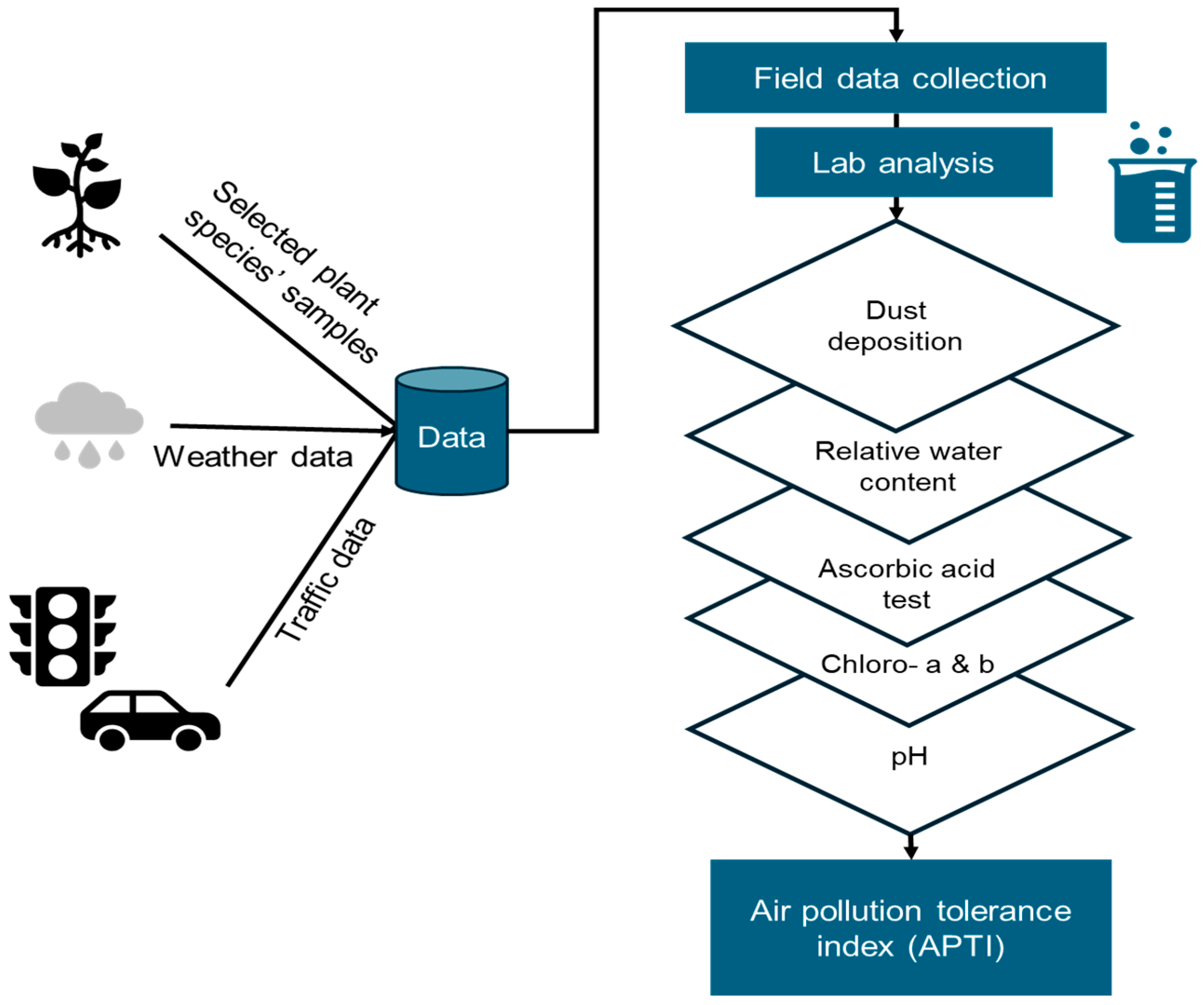

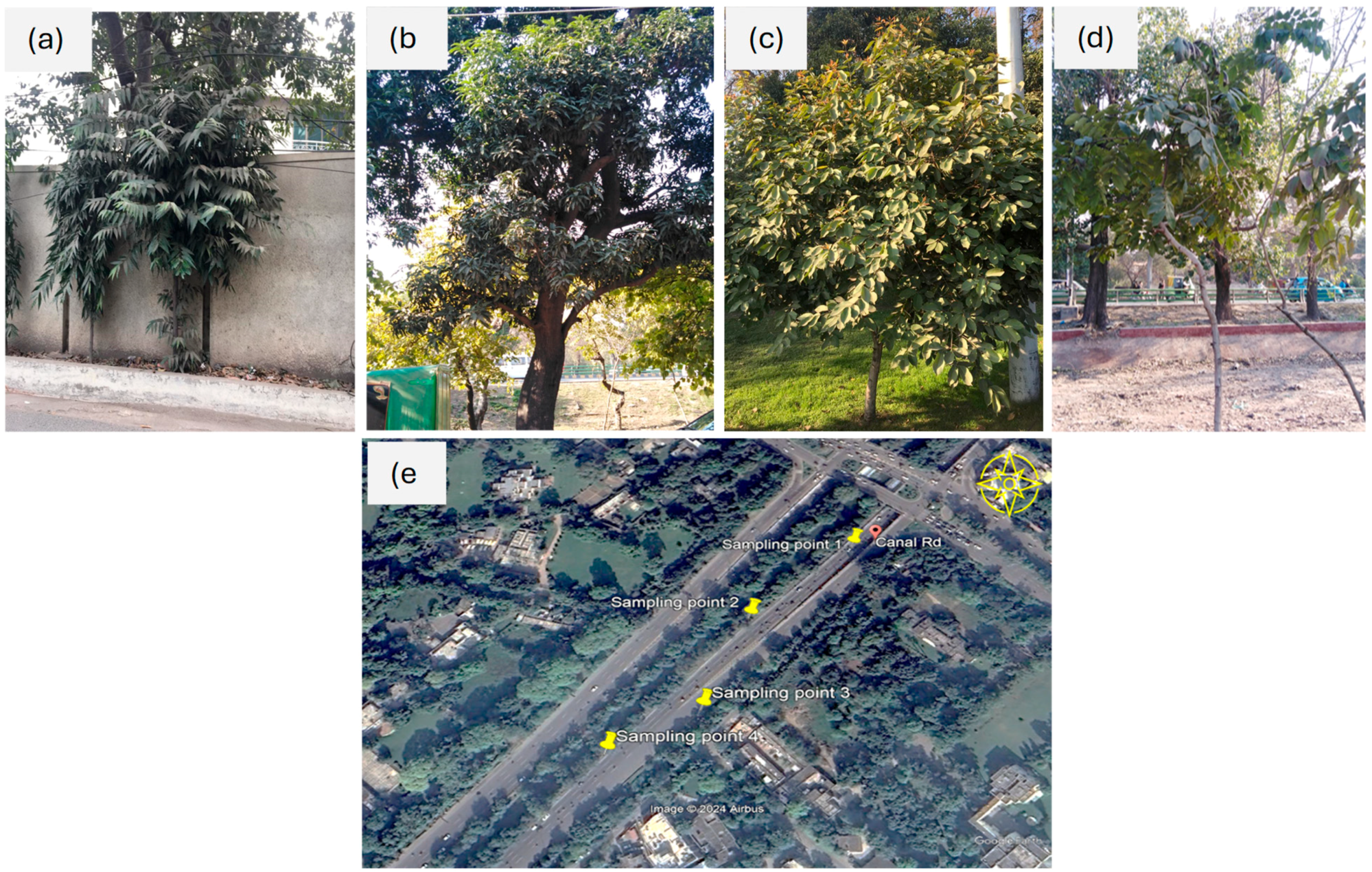
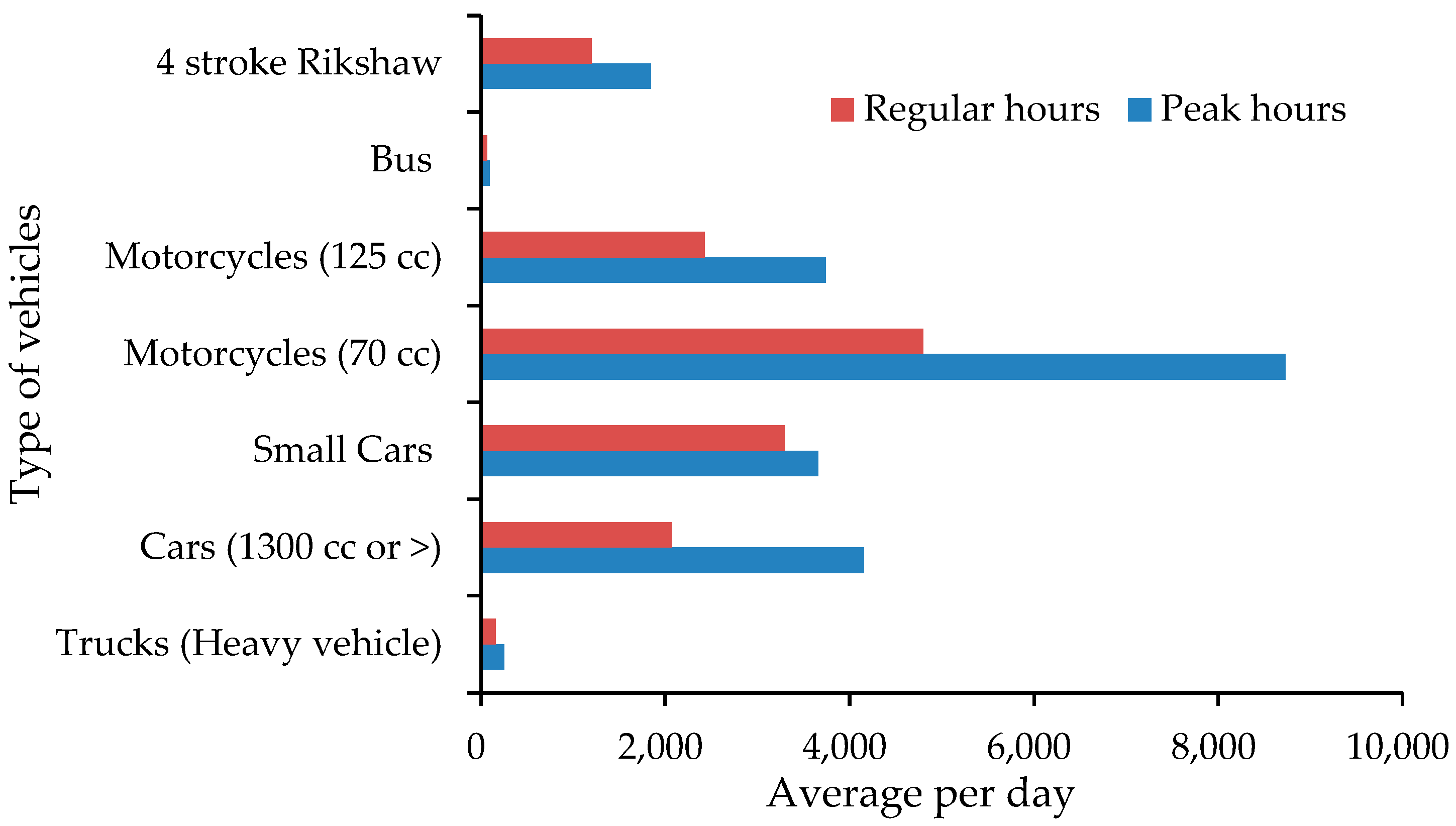
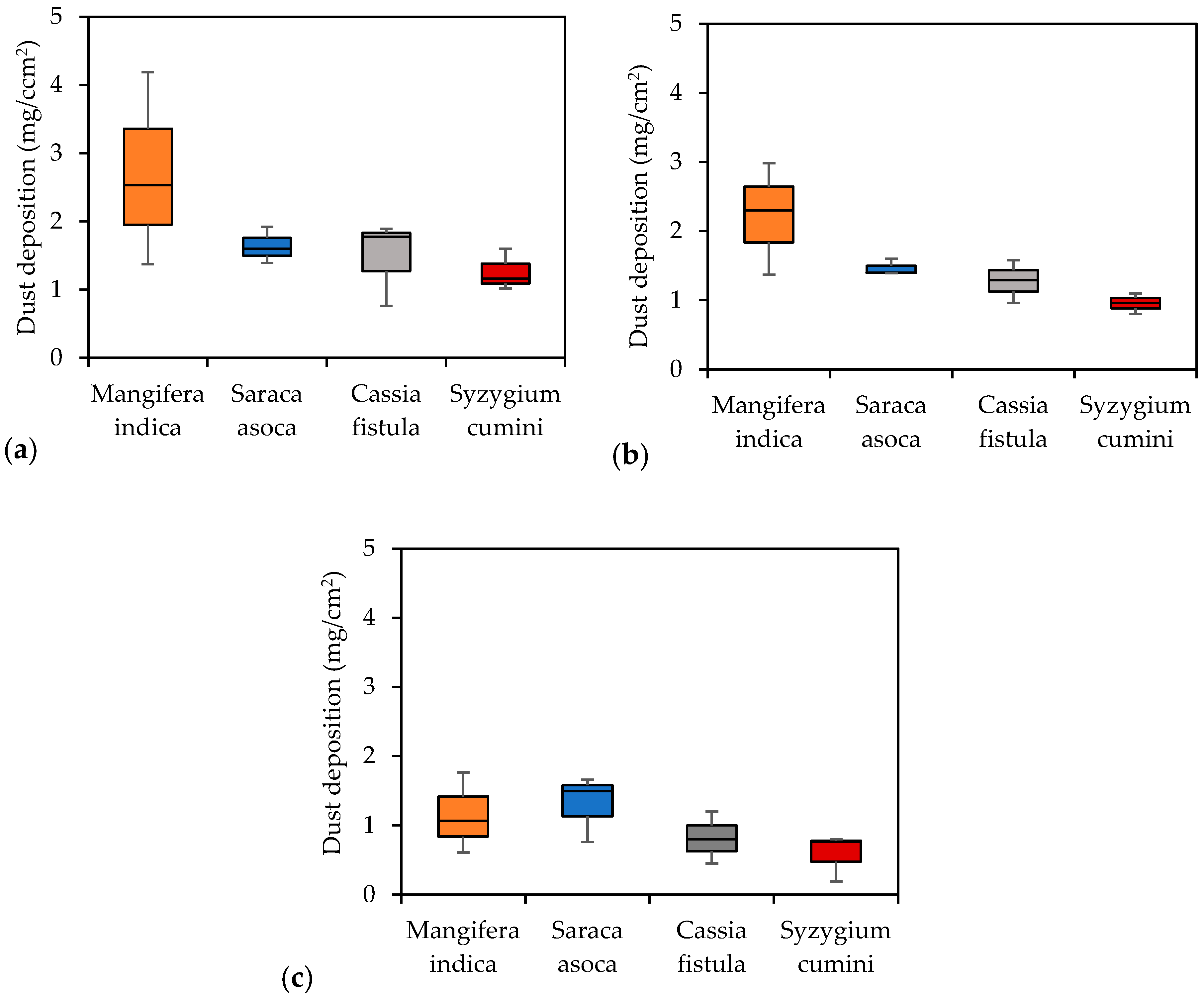
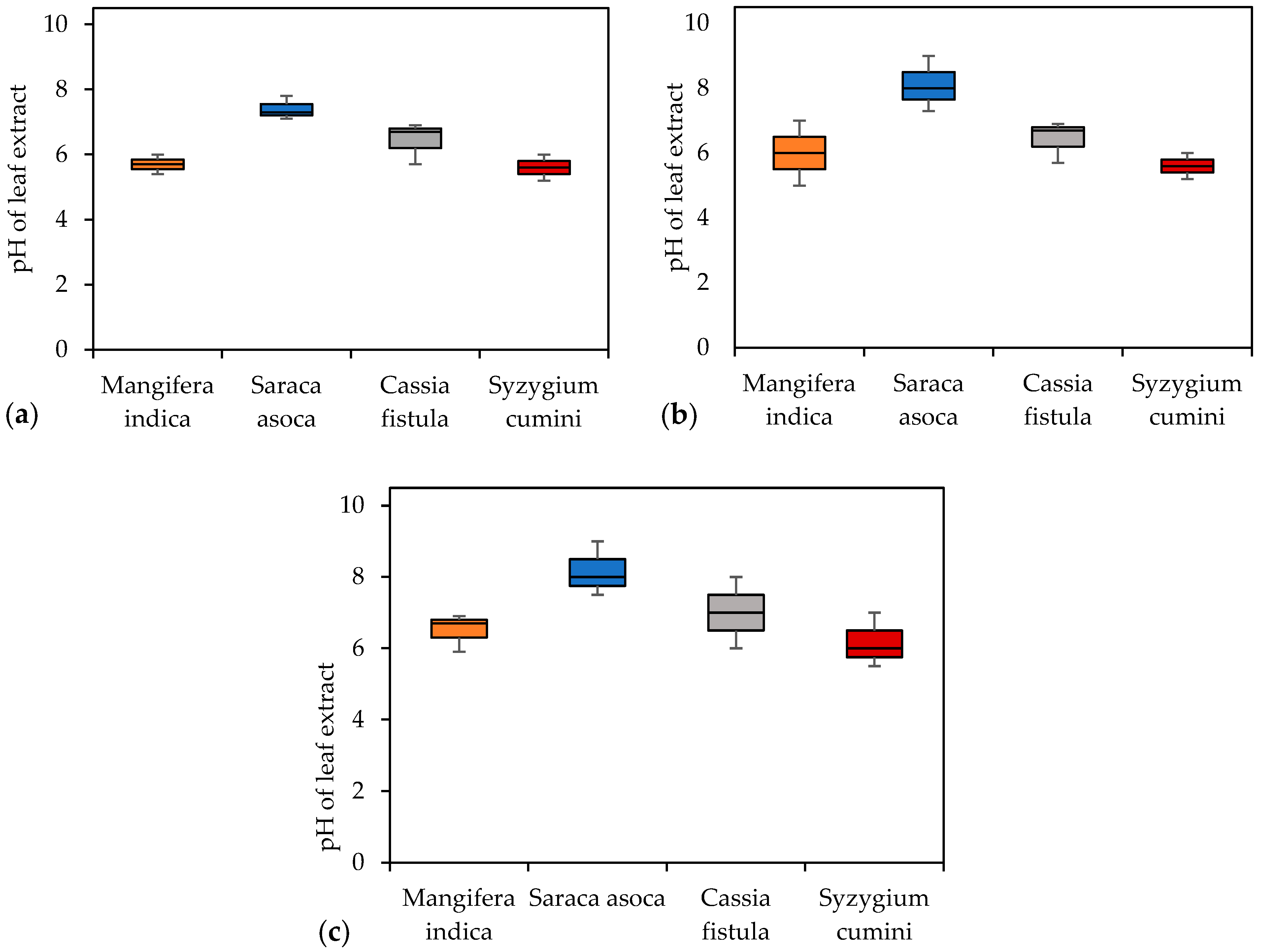

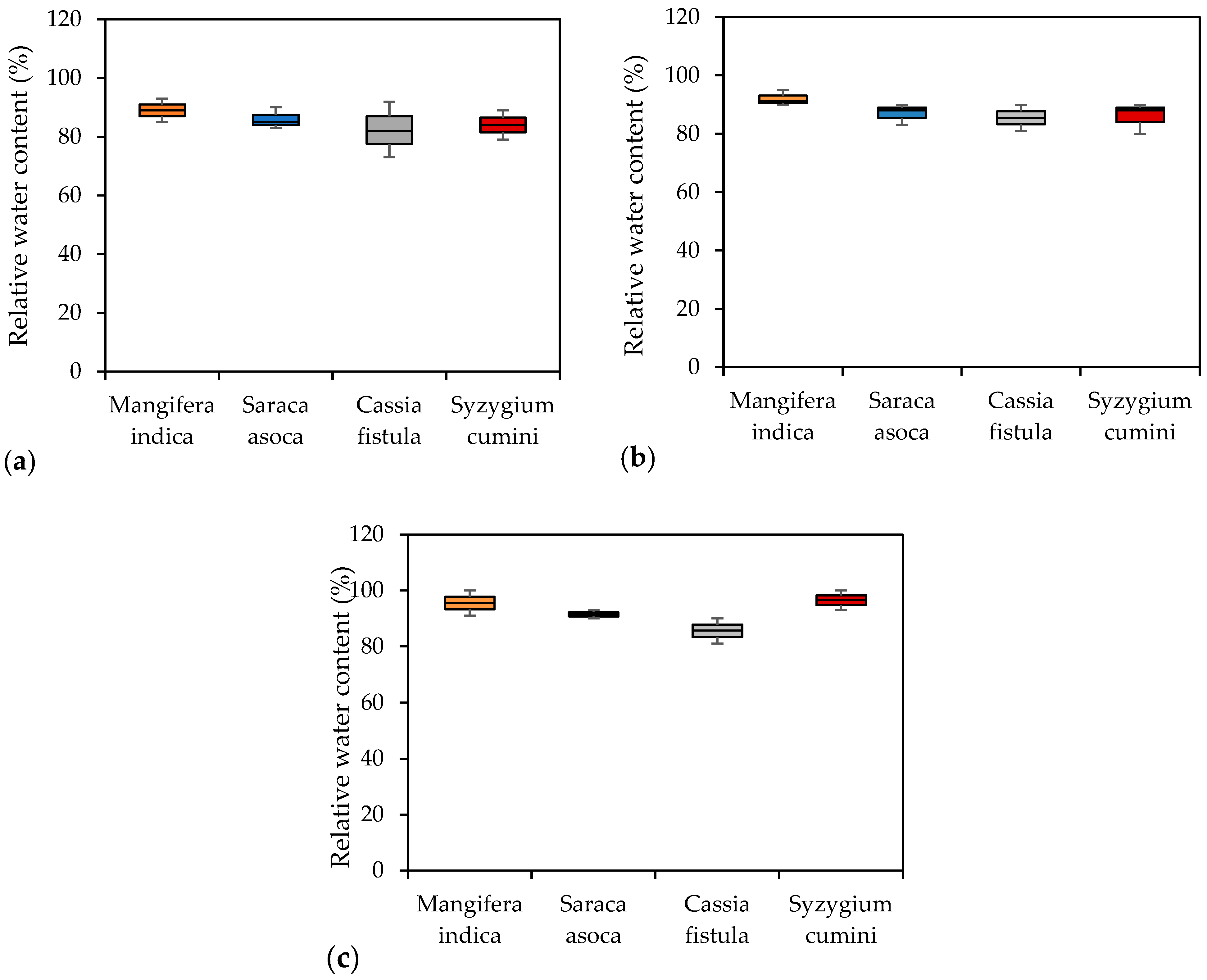


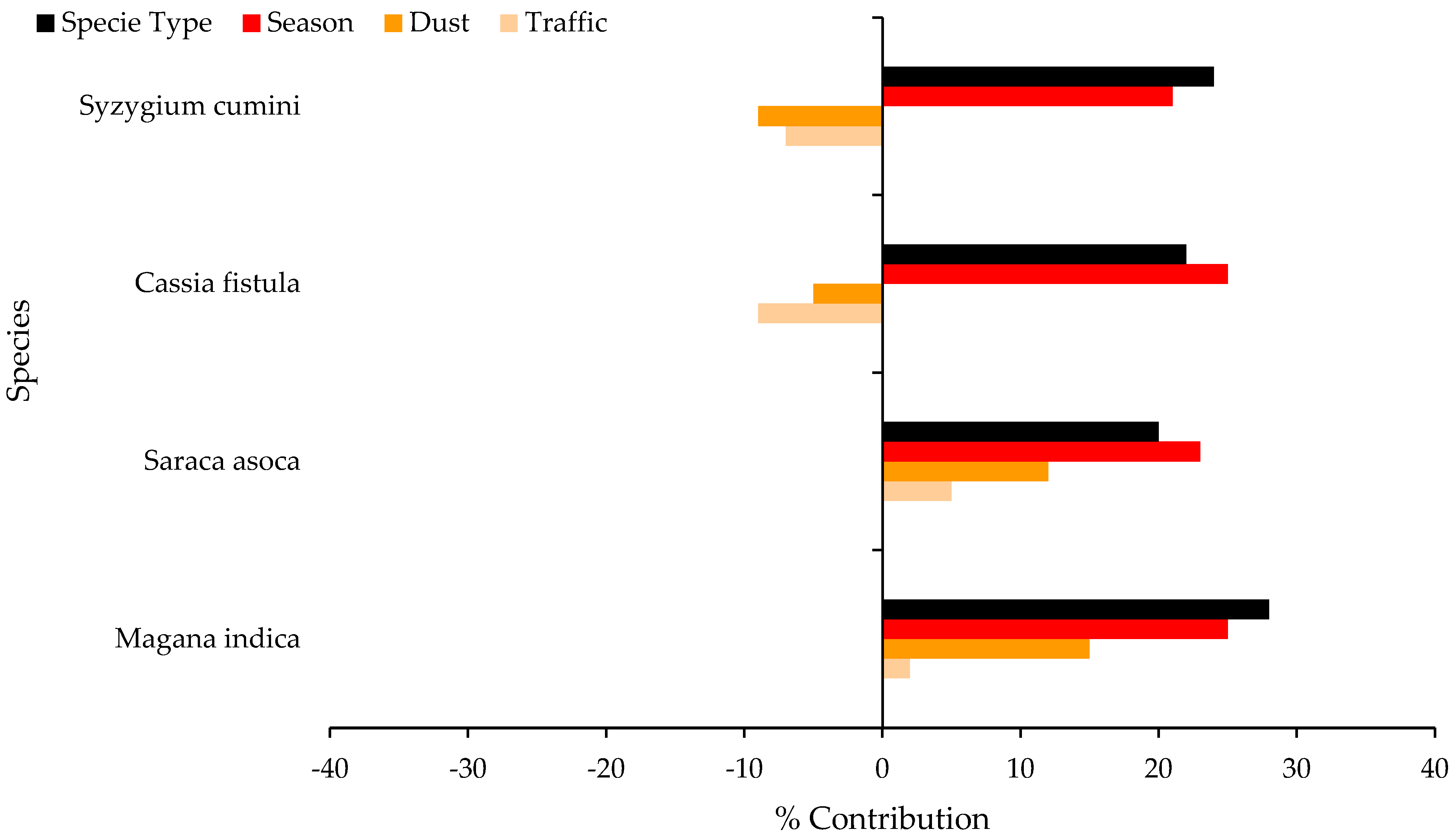
| Species | Seasons | Dust Deposition in Current Study (mg/cm2) (Mean ± SD) | APTI in Current Study (Mean ± SD) | Literature Values * | Sources | References | |
|---|---|---|---|---|---|---|---|
| Peak Traffic Hours (8:00–10:00 am) | Normal Traffic Hours (11:00 am–1:00 pm) | ||||||
| Mangifera indica | Summer | 2.28 ± 0.80 | 13 ± 0.7 | 13.4 ± 0.45 | 16.21 | Samples from various places in a city (Baroda, India) | [31] |
| Winter | 2.69 ± 1.4 | 12.51 ± 1.2 | 12.9 ± 0.8 | 12.7 | Roadside with heavy traffic in Mumbai, India | [32] | |
| Monsoon | 1.14 ± 0.58 | 14.75 ± 0.4 | 14.5 ± 1.1 | ||||
| Saraca asoca | Summer | 1.46 ± 0.11 | 9.84 ±1.0 | 9.96 ± 1.4 | 10.77 | Around university campus, Gujrat, India | [33] |
| Winter | 1.64 ± 0.26 | 9.51 ± 0.3 | 10.1 ± 0.23 | 8.45 | Roadside along orange line metro, Lahore, Pakistan | [34] | |
| Monsoon | 1.31 ± 0.47 | 9.91 ± 0.07 | 10.7 ± 0.29 | ||||
| Cassia fistula | Summer | 1.26 ± 0.30 | 13.19 ± 0.4 | 13.7 ± 0.6 | 11.7 | Roadside with heavy traffic in Mumbai, India | [32] |
| Winter | 1.47 ± 0.62 | 9.63 ± 1.2 | 9.9 ± 0.72 | 14.34 | Around university campus, Gujrat, India | [33] | |
| Monsoon | 0.82 ± 0.37 | 13.82 ± 0.06 | 14.1 ± 0.56 | ||||
| Syzygium cumini | Summer | 0.954 ± 0.15 | 9.73 ± 0.06 | 10.49 ± 1.09 | 10.87 | Around university campus, Gujrat, India | [33] |
| Winter | 1.26 ± 0.30 | 9.39 ± 0.09 | 9.87 ± 0.07 | ||||
| Monsoon | 0.59 ± 0.34 | 10.18 ± 0.5 | 10.68 ± 1.30 | ||||
| Parameters | Total Chlorophyll | PH | Relative Water Content | Ascorbic Acid | APTI | Dust Deposition |
|---|---|---|---|---|---|---|
| Total chlorophyll | 1 | 0.39 ** | 0.23 (ns) | 0.095 (ns) | 0.42 ** | −0.404 ** |
| pH (leaf extract) | 1 | −0.078 * | 0.156 ** | 0.169 ** | −0.59 ** | |
| Relative water content | 1 | −0.51 ** | 0.82 * | −0.35 (ns) | ||
| Ascorbic acid | 1 | 0.92 ** | 0.29 (ns) | |||
| APTI | 1 | −0.86 * | ||||
| Dust deposition | 1 |
Disclaimer/Publisher’s Note: The statements, opinions and data contained in all publications are solely those of the individual author(s) and contributor(s) and not of MDPI and/or the editor(s). MDPI and/or the editor(s) disclaim responsibility for any injury to people or property resulting from any ideas, methods, instructions or products referred to in the content. |
© 2024 by the authors. Licensee MDPI, Basel, Switzerland. This article is an open access article distributed under the terms and conditions of the Creative Commons Attribution (CC BY) license (https://creativecommons.org/licenses/by/4.0/).
Share and Cite
Asif, Z.; Ma, W. Assessing the Air Pollution Tolerance Index of Urban Plantation: A Case Study Conducted along High-Traffic Roadways. Atmosphere 2024, 15, 659. https://doi.org/10.3390/atmos15060659
Asif Z, Ma W. Assessing the Air Pollution Tolerance Index of Urban Plantation: A Case Study Conducted along High-Traffic Roadways. Atmosphere. 2024; 15(6):659. https://doi.org/10.3390/atmos15060659
Chicago/Turabian StyleAsif, Zunaira, and Wen Ma. 2024. "Assessing the Air Pollution Tolerance Index of Urban Plantation: A Case Study Conducted along High-Traffic Roadways" Atmosphere 15, no. 6: 659. https://doi.org/10.3390/atmos15060659
APA StyleAsif, Z., & Ma, W. (2024). Assessing the Air Pollution Tolerance Index of Urban Plantation: A Case Study Conducted along High-Traffic Roadways. Atmosphere, 15(6), 659. https://doi.org/10.3390/atmos15060659






